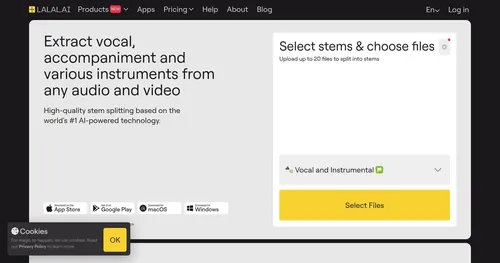MMAudio

MMAudio is an online platform that uses AI to generate synchronized audio from uploaded videos. It processes MP4 files up to 50MB by analyzing visual content, motion, and user prompts to produce sound effects, ambient noise, and atmospheric elements. The tool operates in three steps: upload the video, run AI analysis on context and movement, and output a professional audio track. Key features include Intelligent Environmental Sound Synthesis for ambient sounds based on scene context, AI-Powered Audio Customization for adjusting levels and effects, Multi-Modal AI Analysis for integrating visual and text inputs, High-Fidelity AI Audio Generation for studio-quality results, and Lightning-Fast AI Processing for outputs in minutes.
The platform supports applications in educational content for engaging materials, film and video production for scene-matched soundscapes, game development for dynamic effects, historical film enhancement for accurate audio, social media content for increased engagement, and storytelling for emotional depth. It draws from training on datasets like AudioSet and VGGSound to ensure contextual accuracy. Users report strong synchronization in short clips, such as water breaking or waves lapping, with examples demonstrating crisp, natural results.
Competitors include ElevenLabs Sound Effects, which generates isolated sounds but requires manual syncing, and HunyuanVideo-Foley, an open-source option with superior handling of complex animations via its MMDiT architecture. MMAudio’s credit-based pricing starts with one credit per generation and offers tiered plans, providing better value for video-specific tasks than ElevenLabs’ per-minute model. Users appreciate the ease for quick prototypes but note limitations like English-only prompts and file size caps.
Forum feedback from Reddit highlights reliable performance for AI video enhancement, though some clips show minor sync delays on rapid actions. X users share successes in creative workflows, like adding effects to Midjourney outputs, but mention occasional over-dramatized noises. A surprise element is its experimental image-to-audio capability, which extends use to static visuals by simulating motion.
The tool processes via advanced algorithms for semantic and temporal alignment, achieving state-of-the-art results in public benchmarks.
Test the tool on a 10-second clip with a basic prompt, then adjust one effect to refine output before scaling to longer projects.
Video Overview ▶️
What are the key features? ⭐
- Intelligent Environmental Sound Synthesis: Analyzes scene context to produce realistic ambient sounds that enhance immersion.
- AI-Powered Audio Customization: Provides controls to adjust sound levels, effects, and personalization for creative output.
- Multi-Modal AI Analysis: Processes visual cues, motion, and text prompts simultaneously for synchronized audio.
- High-Fidelity AI Audio Generation: Delivers studio-quality tracks with precise timing and natural transitions.
- Lightning-Fast AI Processing: Completes audio generation in minutes while preserving high standards.
Who is it for? 🤔
Examples of what you can use it for 💭
- Filmmaker: Uses MMAudio to generate synchronized soundscapes for silent scenes, matching actions like footsteps or doors creaking to visual cues.
- Educator: Adds ambient audio to lecture videos, such as lab equipment hums, to increase student focus and realism.
- Game Developer: Prototypes dynamic effects for levels, like rustling foliage, synced to player movements in test clips.
- Social Media Creator: Enhances short reels with attention-grabbing noises, like crowd cheers, to drive views and shares.
- Archivist: Revives historical clips by synthesizing era-specific sounds, such as typewriter clacks, based on visual analysis.
Pros & Cons ⚖️
- Fast processing
- Strong sync accuracy
- Easy customization
- English prompts only
FAQs 💬
Related tools ↙️
-
 LALAL.AI
Extract vocal, accompaniment and various instruments from any audio and video
LALAL.AI
Extract vocal, accompaniment and various instruments from any audio and video
-
Mivi Audio Creates personalized audio experiences through AI-driven avatars and customization
-
 Podcastle
Audio & video creation platform for the creation, editing, and distribution of podcasts
Podcastle
Audio & video creation platform for the creation, editing, and distribution of podcasts
-
Framedrop Transforms video and audio into multi-platform content with AI automation
-
 Stable Audio
An AI tool that produces high-quality music and sound using audio diffusion technology
Stable Audio
An AI tool that produces high-quality music and sound using audio diffusion technology
-
 Papercup
Translate videos by generating voices that sound like the original speaker
Papercup
Translate videos by generating voices that sound like the original speaker

